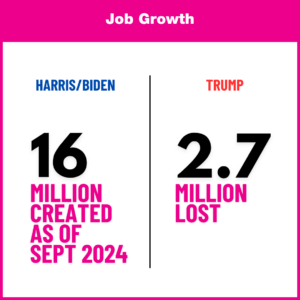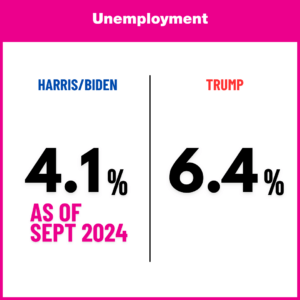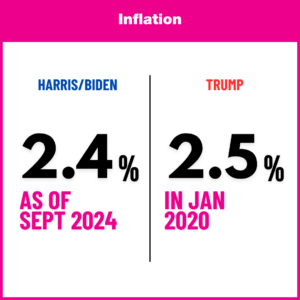American voters rarely have the opportunity to compare the records of two presidential candidates’ first terms on the job when they’re running for election. The last time it happened was 1892, when Republican incumbent Benjamin Harrison ran against Democratic nominee Grover Cleveland, who served his first term in office between 1885 and 1889. Now that it’s happening again with Vice President Kamala Harris and former President Trump in the 2024 election — and now that we have all kinds of ways to measure, say, the candidates’ records on the economy — we thought we’d do just that.
Harris v. Trump isn’t a president-to-president comparison, but it’s close. The vice president is asking the American people for a major promotion — and leaning on the record of the Biden / Harris administration to do it. Although the Democratic nominee has been clear about distinguishing herself from President Biden, she’s also embraced President Biden’s achievements as her own. “I’ve been a part of most of the decisions that have had impact,” she said on The View,
So, let’s compare: first term to first term. Eighty-one percent of voters say the candidates’ record on the economy will play a major role in determining their vote, per a Pew Research Center survey. Americans are concerned about job growth, the costs of groceries and a host of other factors that affect the cost of living.
Worth pointing out: This cycle’s oft-quoted statistic from LendingClub that 60 percent of Americans live paycheck-to-paycheck is misleading: It doesn’t distinguish between high-income earners struggling due to lifestyle creep and people struggling with basic necessities — food, student loan repayment or childcare costs, for instance. Four out of 10 high-income earners in LendingClub’s survey said they live paycheck-to-paycheck, when, in reality, they still have emergency and retirement savings. More accurately, the survey notes that 18.5 percent of all respondents say they struggle to pay their bills.
Also note: Most economists will note that much of a president’s influence in the economy is indirect, at best. Presidents must create all legislation through Congress — a major obstacle when the president’s party doesn’t have the majority in Congress. Presidents also have the power to appoint members and the chair of the Federal Reserve, although historically, the Fed has operated independently of presidential influence. They can also use their position as a public figure to wield influence.
That said, since we are keeping score: 10 out of 11 recessions in the modern era began under Republicans.
Here’s a look at what Trump and Harris have done to help Americans out.

 Trump: Lost 2.7 million jobs
Trump: Lost 2.7 million jobs
When Trump entered office, he inherited a strong economy with robust job growth (11.6 million jobs over 8 years, to be exact) from the Obama administration. When Trump left office, he did so with fewer jobs than when he entered — he’s the only modern U.S. president to do so in one term.
To be fair, he faced some fairly unprecedented challenges. Covid radically reshaped our economy at the end of Trump’s term. Between his inauguration in January 2017 and February 2020, jobs increased by about 7 million. Those gains disappeared — and then some — during the months that followed, when Covid shut down much of the economy for months.
Even before Covid, though, the manufacturing revival Trump promised PA never manifested — the state lost 7,400 manufacturing jobs between 2018 and 2019. It averaged 565,600 manufacturing jobs monthly during the first three years of his term. During Obama’s last three years in office the monthly average was 566,100.
Harris / Biden: Created 16 million jobs as of September 2024
The Biden-Harris administration recorded the strongest annual pace of job growth over a single term since 1981, when Jimmy Carter left office. (It’s worth noting that not a lot of modern presidents serve only a single term.) Carter created 9.8 million jobs. With 18.6 million jobs over two terms, Bill Clinton holds the job creation record.
Some of that is post-Covid bounceback, but job growth under Biden-Harris has consistently surpassed economists’ expectations. Last month, job growth surpassed expert predictions by more than 100,000 positions. Pennsylvanians are benefiting from this job growth in industries like clean energy, where Biden-Harris policies contributed to the creation of 2,881 new jobs.

 Trump: 6.4 percent
Trump: 6.4 percent
Unemployment is another area where the pandemic significantly affected Trump’s numbers. Before the pandemic, his unemployment rate was 3.5 percent; by the time he left office, it had risen to 10 percent. (By comparison, under Obama, the unemployment rate went from 10 percent at the height of the Great Recession to 4.6 percent at his terms’ end.) Trump’s economic response to Covid was not to address the crisis head on; he created no comprehensive economic plan to address the immediate crisis or its long-term impacts. (Those Covid checks that went out to Americans were an act of Congress; when Trump insisted his signature be added to each one, he delayed their distribution.) Instead, he minimized the pandemic.
Toward the end of his term, he did work with House Democratic leadership on the CARES Act, which set the economy up for improvement under Biden. On the other hand, in August 2020, rather than work across the aisle to ensure increased unemployment benefits, he tried to sign an executive order requiring states to pick up a portion of the costs of increased unemployment benefits. PA’s Department of Labor & Industry said that plan wasn’t feasible for them to implement, WHYY reported at the time.
Harris / Biden: 4.1 percent as of September
Biden-Harris boasted the lowest unemployment levels in 54 years when it hit 3.4 percent in February, 2023. It’s creeped up since then, but it’s in line with the Federal Reserve’s median, long-term projection. In August 2023, 79 metro areas, including Pittsburgh, Erie, Scranton and several others in PA, saw record low unemployment. The unemployment rate for Black Americans was the lowest it had ever been in April 2024, as was the gap between unemployment rates for White and Black Americans.

 Trump: Annual Average Growth 2.5 percent
Trump: Annual Average Growth 2.5 percent
Overall, the Gross Domestic Product (GDP) growth under Trump was similar to Obama’s record. GDP measures the economic values of all goods produced and services rendered in a given country. (We’re using real GDP growth values which are adjusted for inflation.) During the first three years of Trump’s term, the GDP grew by 2.5 percent annually on average. That’s comparable to the 2.3 percent average annual growth Obama saw during his last three years in office. The GDP fell 3.5 percent at the end of 2020. Germany, Italy and others in Europe saw quicker recoveries than the U.S. in 2020 under Trump.
Harris / Biden: Annual Average Growth 3.6 percent
The annual average real GDP growth rose 3.6 percent on average during the first three years of the Biden-Harris administration. Biden’s policies, including the American Rescue Plan in his first year, averted a recession and contributed to one of the fastest growing economies in decades. Annual real GDP growth in his first year was 5.7 percent. It slowed to 2.1 percent in 2022 and rose to 3.1 percent in 2023 — a year when many economists predicted a recession. Many experts expected it to take longer for the GDP to recover from the shocks of the pandemic. Other G7 countries have not experienced as quick of a bounce back as the U.S.

 Trump: 2.5 percent in January 2020
Trump: 2.5 percent in January 2020
Inflation remained low through the course of Trump’s presidency. Trump and Harris have sparred over who’s to blame for inflation rising rapidly during the first two years of the pandemic. Experts say it’s complicated. Notably, 16 Nobel Prize-winning economists have concerns that his 2024 campaign promises will make inflation worse. The Peterson Institute for International Economics predicts inflation will rise to between 6 and 9.3 percent if Trump is successful in passing his current tariff proposals.
Harris / Biden: 2.4 percent as of September 2024
Biden’s first two years in office were plagued by high inflation. It rose to a peak of 9.1 percent in June 2022. Since then, the Biden-Harris administration has wrangled it back down to 2.4 percent, comparable to where it was when Trump left office. Many Americans are still feeling the effects, however, particularly when prices of goods and services rise faster than wages. When that happens, people walk through the grocery store wondering why their paycheck doesn’t stretch as far as it used to.

 Trump: Increased by 8.4 percent
Trump: Increased by 8.4 percent
Despite the loss of jobs and increased unemployment, wage rises outpaced the rate of inflation, allowing real weekly earnings to increase by 8.4 percent by the time Trump left office. He’s campaigned on this record, and these stats likely contribute to why many Americans remember a strong economy under Trump.
Harris / Biden: Decreased by about 2 percent as of June 2024
Over the course of Biden’s entire presidency, inflation outpaced wage growth, Poynter reported, with a caveat that between 2022 and 2024 wage growth narrowly outpaced inflation. Wages have also outpaced inflation compared to pre-pandemic levels, per Poynter’s reporting. Wages have increased for younger workers by 13 percent in October 2022. Those in low-wage sectors also saw wage increases under Biden.

 Trump: Brought in $79 billion for the U.S. government in 2019
Trump: Brought in $79 billion for the U.S. government in 2019
During his first term, Trump levied tariffs on everything from solar panels to washing machines and a vast array of goods made in China. His logic: Taxing imported goods would protect American jobs and wages. In theory, these taxes are paid by the exporting companies, but they can also be borne by American companies that import the goods and pass these increased expenses onto consumers.
Tariffs did cause U.S. companies to import significantly fewer Chinese goods, but at significant cost to the American people. Researchers in several different studies found Americans — not foreign companies or nations — are predominantly paying for Trump’s tariffs, by an average of $460 per year per household. Trump’s steel tariffs collectively cost Americans $900,000 for each of the about 4,600 jobs it created in its first year (that’s a loss of more than $4 billion). These gains were offset by losses in industries that rely on imported goods. In total, the nonpartisan Tax Foundation estimates Trump tariffs have cost Americans $80 billion.
Harris / Biden: Introduced new tariffs on $18 billion worth of Chinese goods. The policy took effect in September 2024
Biden promised to remove tariffs imposed by Trump during his 2020 campaign. He did not do that. Instead, he doubled down on Trump’s approach and implemented more tariffs. Though there is no data yet on how new tariffs will affect tax revenue and U.S, consumers, experts predict it they, and other potential tariffs, will be cataclysmic for the American economy. Still, they have support amongst Americans. A 2024 survey found that 76 percent of PA Republicans and 82 percent of PA Democrats support a 20 percent tariff on goods imported from China. Harris, in a break from the Biden administration’s policies, has been critical of Trump’s tariffs on the campaign trail.
Republicans and 82 percent of PA Democrats support a 20 percent tariff on goods imported from China.
![]() MORE ON THE 2024 ELECTION ISSUES
MORE ON THE 2024 ELECTION ISSUES



